This preschool science activity is great for St. Patrick’s Day! We experiment with baking soda and vinegar using a special dough mixture to make Fizzing Shamrocks. Here is a step-by-step picture tutorial of how to complete the activity, including expanded questions to discuss with the children. This activity requires freeze time, so plan to provide other activities while waiting.
What You’ll Need:
- large bowl
- cookie sheet
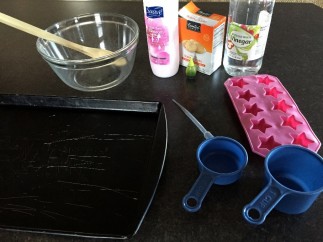
- shamrock silicone mold (optional)
- spoon
- measuring cups
- hair conditioner
- baking soda
- vinegar
- food coloring (optional)
- pipettes
Step 1: Recap what a shamrock looks like with the children. Remind them that shamrocks generally have three leaves. Today the children will get to do a science experiment with dough that is shaped like a shamrock.
Step 2: Mix 3 cups of baking soda with ½ cup hair conditioner. (Any kind of hair conditioner should do). Supervise closely to make sure children do not put conditioner in their mouths. Store the conditioner out of reach after this activity. If you would like to make your shamrocks green, you can use green conditioner or add a few drops of green food coloring into a light-colored conditioner. I had pink hair conditioner, so I chose to add green food coloring.) You may need to add more baking soda or hair conditioner to get the right consistency. The dough is ready when it is moldable with your hands. As you stir, invite the children to participate by stirring. Ask them what is happening to the ingredients as they mix together.
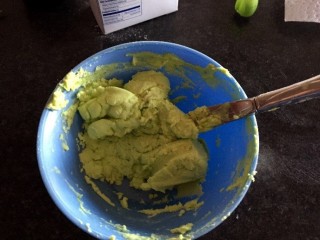
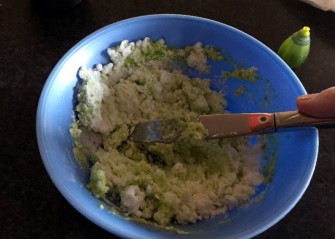
(For this sample, I mixed less in a small bowl.)
Step 3: If you have a silicone mold with shamrock shapes, fill each section with dough. (I have a pink star silicone mold in the picture under Step 1 if you are not sure what a silicone mold is.) If you do not have a silicone shamrock mold, have the children help you roll the dough into small balls, and place three small balls together on a cookie sheet to resemble a shamrock as I did below. If the dough is not moldable, you may need to adjust your ingredients. As the children work the dough, ask them how the dough feels. Is it cool or warm? Is it soft or rough?
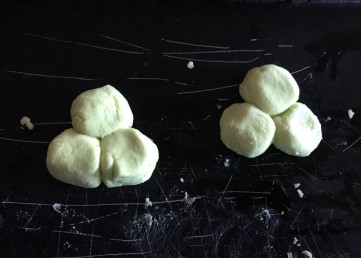
Step 4: Once the silicone mold is full or the dough has been formed into shamrocks, place the cookie in the freezer for at least one hour.
Step 5: Remove the cookie sheet from the freezer and place it on a tabletop. Gently press the silicone mold so the dough pops out of the mold. If you made shamrocks with dough balls, gently lift the dough off the cookie sheet. You might want to use a spatula if they stick to the tray. Allow each child to briefly hold a shamrock. How does it feel?
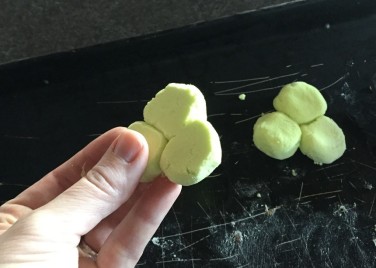
Step 6: Pour vinegar into cups or small bowls, and offer pipettes to the children. Ask them to predict what will happen when they squeeze vinegar onto the shamrocks. Did anyone say the shamrocks will fizz? Some children may have experimented with vinegar and baking soda or similar ingredients in the past. Acknowledge that their past experiences helped them predict today!
Invite the children to soak up vinegar with the pipette and squeeze it over the shamrock. What happens? Explain that when the vinegar combines with the baking soda in the dough, a chemical reaction takes place. That means that a change occurs when the two ingredients mix.
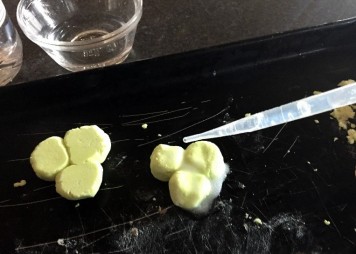
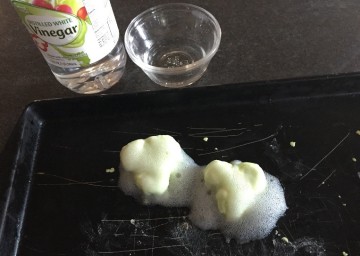
Allow the children to continue adding vinegar and watching the shamrocks fizz. They may even wish to pick up the dough and see how it feels. Have paper towels handy nearby, as the dough might begin to stick to the children’s hands once it warms up.
Back to blog listing